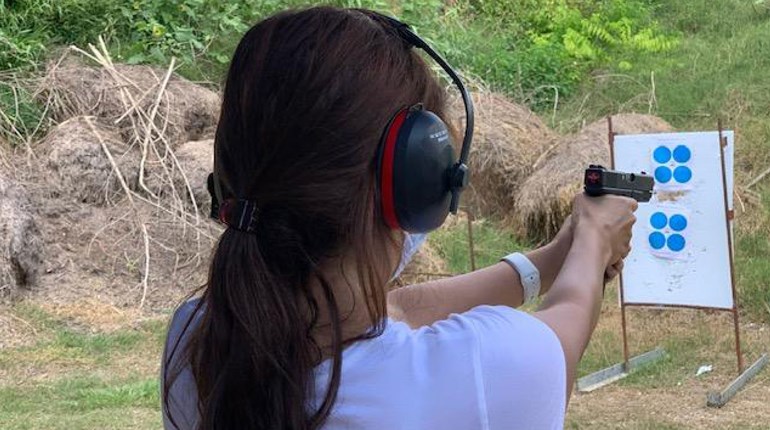
The common belief that a bullet rises when it leaves the barrel is the most widely disseminated myth among firearm “experts.” But there is a good explanation for this belief, and it has roots in science since the 17th century.
To believe a projectile rises above a straight plane is to disbelieve science. You see, there is a force called gravity that acts upon all objects on all planets, or in our case, Earth. The law of gravity was introduced to us in 1687 by Sir Isaac Newton. Scientific law is a statement that describes an observable occurrence in nature that appears to always be true. Before something becomes scientific law, it is a scientific theory. After repeated tests and observation, the scientific theory becomes scientific law if it can predict natural phenomena.
The law of gravity is the force between two objects with mass. Sir Newton’s law of gravity is now recognized as law of universal gravitation, which is that the force of gravity acts between all objects in the universe. Without exception, any two objects in the universe are attracted to each other. The object with a smaller mass is attracted to objects with a larger mass. In relation to the subject matter, the bullet fired from a firearm is attracted to the Earth. As soon as the bullet leaves the barrel it is begins to fall, regardless of the muzzle velocity. The higher the velocity, the longer it takes gravity to significantly affect the bullet. Generally speaking, that is why a bullet that has a high muzzle velocity has a flatter “bullet trajectory.”
The law of universal gravitation means that a bullet leaving the muzzle of the barrel travels in a straight line from the muzzle until the effects of gravity. As stated above, the effect of gravity starts working on the bullet immediately. This is often referred to as the “arc of travel” or “bullet travel.” The arc of travel is often depicted as a curved line that crosses the line of sight at two points.

Bullet trajectory refers to the line of sight of the shooter in relation to bullet travel. To put it simply, trajectory is the line of sight of the shooter. This is the key to understanding when individuals refer to the Trajectory of a bullet. Individuals that believe that the bullet rises above the barrel is confusing “bullet travel” with “bullet trajectory.”
A bullet’s trajectory is parabolic. The parabola consists of focus and directrix. The focus is the fixed point or in terms of shooting, where bullet leaves the muzzle. The shooter aims, which includes sight alignment and sight picture, at a target. The directrix is where the shooter is aiming such as a target at the gun range or game when hunting.
This can be confusing because the pictures and graphics that depicts this concept shows a straight line from the shooter to the target and the path of the bullet rising above plane of sight. Though it is true, a bullet’s trajectory is a straight line and the bullet’s travel is a smooth arc toward the ground because of the effects of gravity. Most pictures and graphics fail to explain what is really happening.
The barrel of the firearm must be slightly elevated when fired, or the bullet would drop and come into contact with the ground very fast and relatively close to the where the projectile exits the muzzle. In reality, the rifle muzzle is elevated, and the line of sight is downward toward the target. To put it in reference, when your sights are on a target, your barrel is pointed upward. Even at close range, the muzzle is elevated, be it very slightly and when aiming, the line of sight is slightly downward. This means the line of sight and the bullet’s path will intercept at two points downrange.
This is why we must adjust the rear sight when making sight adjustments. The rear sight is raised to move the front sight upward to counter the effects of gravity. Remember, you move the sights in the direction that you want your bullet to impact the target. The higher the front sight, the shorter the distance between the intercept lines of the trajectory. Think of the aperture sight on an original M16. The rear sight is located on top of the carrying handle several inches above the barrel and the front sight is also elevated and located toward the end of the barrel. This was done so the soldier carrying the M16 did not have to be a sniper to hit targets 300 meters away.
The myth of the rising bullet has been used for generations to explain how a bullet reaches the intended target. I have heard firearm instructors incorrectly tell their students that if you are close to your target, you should aim low because your bullet rises when it exits the barrel. If you are teaching incorrect techniques, your students are trained incorrectly.
When we disseminate information regarding firearms, it is important that we understand and provide the correct information. It does not matter if you are giving informal lessons at the range, conducting an NRA Firearm Training course, or just educating the public. According to the NRA Basic Instructor Training (BIT) course, the expected retention rate of your students is 65 percent. That means if you are disseminating incorrect information, that may be part of the 65 percent retained.
Unfortunately, it is untrained firearm instructors and other experts that are spreading this disinformation. You must understand the relationship between sighting in on a target and the path the bullet takes to properly teach someone how to shoot a firearm safely and correctly. By understanding this relationship, teaching proper aiming makes more sense. According to the NRA, the Instructor Training Goal is “to develop NRA Certified Instructors who possess the Knowledge, Skills, and Attitude necessary to organize and conduct NRA Basic Firearms Training Courses.”
Remember—perfect practice makes perfect training!














































